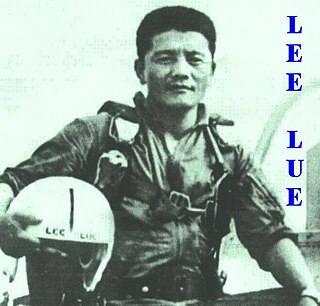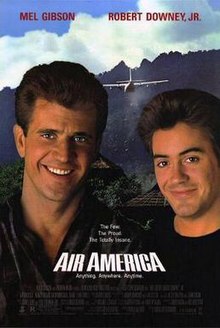
The Laotian Civil War (1959–1975) was a civil war in Laos waged between the Communist Pathet Lao and the Royal Lao Government from 23 May 1959 to 2 December 1975. It is associated with the Cambodian Civil War and the Vietnam War, with both sides receiving heavy external support in a proxy war between the global Cold War superpowers. It is called the Secret War among the American CIA Special Activities Center, and Hmong and Mien veterans of the conflict.

Air America was an American passenger and cargo airline established in 1946 and covertly owned and operated by the Central Intelligence Agency (CIA) from 1950 to 1976. It supplied and supported covert operations in Southeast Asia during the Vietnam War, including providing support for drug smuggling in Laos.
Civil Air Transport (CAT) was a Nationalist Chinese airline, later owned by the U.S. Central Intelligence Agency (CIA), that supported United States covert operations throughout East and Southeast Asia. During the Cold War, missions consisted in assistance to "Free World" allies according to the Mutual Defense Assistance Act of 1949.
Anthony Alexander Poshepny, known as Tony Poe, was a CIA Paramilitary Operations Officer in what became the Special Activities Division. He was known for his service in Laos with Special Guerilla Units (SGUs) under the command of General Vang Pao, a U.S.-funded secret army in Laos during the Vietnam War, and is recognized as the model for Colonel Kurtz in the movie Apocalypse Now.
Edgar "Pop" Buell was a humanitarian aid worker in Laos. He was a farmer in Steuben County, Indiana until the age of 47, but following the death of his wife in 1958 he joined the International Voluntary Services, a precursor to the Peace Corps, which offered him a job as an agricultural adviser in Laos. Buell worked in Laos through the Laotian Civil War, organizing relief aid to refugees and isolated villages. He was forced to flee Laos in 1974 when the Communist Pathet Lao gained control of the country.

The United States Central Intelligence Agency (CIA) has been accused of involvement in drug trafficking. Books and investigations on the subject that have received general notice include works by the historian Alfred McCoy, professor and diplomat Peter Dale Scott, journalists Gary Webb and Alexander Cockburn, and writer Larry Collins. These claims have led to investigations by the United States government, including hearings and reports by the United States House of Representatives, Senate, Department of Justice, and the CIA's Inspector General.

Major Lee Lue was a Laotian Hmong fighter bomber pilot notable for flying more combat missions than any other pilot in the Kingdom of Laos. Lee Lue flew continuously, as many as 10 missions a day and averaging 120 combat missions a month to build a total of more than 5,000 sorties. Lee Lue was the leader of the special group of Hmong pilots flying T-28Ds from Long Tieng against the Pathet Lao and North Vietnamese positions. The group was funded by the CIA and was part of the regular Royal Lao Air Force, but took orders directly from MR2 Commander Gen. Vang Pao. His T-28 was shot down by anti-aircraft fire over Muang Soui, crashing in a mountainous area near Ban Phou Pheung Noi on July 12, 1969. At the time of his death, he had flown more combat missions than any other pilot in history.

The Battle of Lima Site 85, also called Battle of Phou Pha Thi, was fought as part of a military campaign waged during the Vietnam War and Laotian Civil War by the North Vietnamese People's Army of Vietnam (PAVN) and the Pathet Lao, against airmen of the United States Air Force (USAF)'s 1st Combat Evaluation Group, elements of the Royal Lao Army, Royal Thai Border Patrol Police, and the Central Intelligence Agency-led Hmong Clandestine Army. The battle was fought on Phou Pha Thi mountain in Houaphanh Province, Laos, on 10 March 1968, and derives its name from the mountaintop where it was fought or from the designation of a 700 feet (210 m) landing strip in the valley below, and was the largest single ground combat loss of United States Air Force members during the Vietnam War.

Operation Barrel Roll was a covert U.S. Air Force 2nd Air Division and U.S. Navy Task Force 77, interdiction and close air support campaign conducted in the Kingdom of Laos between 14 December 1964 and 29 March 1973 concurrent with the Vietnam War. The operation resulted in 260 million bombs being dropped on Laos, making Laos "the most heavily bombed nation in history".
CIA activities in Laos started in the 1950s. In 1959, U.S. Special Operations Forces began to train some Laotian soldiers in unconventional warfare techniques as early as the fall of 1959 under the code name "Erawan". Under this code name, General Vang Pao, who served the royal Lao family, recruited and trained his Hmong and Iu-Mien soldiers. The Hmong and Iu-Mien were targeted as allies after President John F. Kennedy, who refused to send more American soldiers to battle in Southeast Asia, took office. Instead, he called the CIA to use its tribal forces in Laos and "make every possible effort to launch guerrilla operations in North Vietnam with its Asian recruits." General Vang Pao then recruited and trained his Hmong soldiers to ally with the CIA and fight against North Vietnam. The CIA itself claims that the CIA air operations in Laos from 1955-1974 were the "largest paramilitary operations ever undertaken by the CIA."
Long Tieng is a Laotian military base in Xaisomboun Province. During the Laotian Civil War, it served as a town and airbase operated by the Central Intelligence Agency of the United States. During this time, it was also referred to as Lima Site 98 or Lima Site 20A.

The Raven Forward Air Controllers, also known as The Ravens, were fighter pilots used as forward air controllers (FACs) in a covert operation in conjunction with the US Central Intelligence Agency in Laos during America's Vietnam War. The Ravens pinpointed targets for most of the air strikes against communist Pathet Lao and People's Army of Vietnam infiltrators in support of the Laotian Hmong guerrilla army.
Jerrold B. Daniels or Jerry Daniels was a CIA Paramilitary Operations Officer (PMOO) in their Special Activities Center who worked in Laos and Thailand from the early 1960s to the early 1980s. He was known by his self-chosen CIA call-sign of "Hog." In the early 1960s, he was recruited by the CIA as a liaison officer between Hmong General Vang Pao and the CIA. He worked with the Hmong people for the CIA's operation in Laos commonly called the "Secret War" as it was little known at the time. In 1975, as the communist Pathet Lao and North Vietnamese Army advanced on the Hmong base at Long Tieng, Daniels organized the air evacuation of Vang Pao and more than two thousand of his officers, soldiers, and their families to Thailand. Immediately after the departure of Daniels and Vang Pao, thousands more Hmong fled across the Mekong river to Thailand, where they lived in refugee camps. From 1975 to 1982 Daniels worked among Hmong refugees in Thailand facilitating the resettlement of more than 50,000 of them in the United States and other countries.
ChristopherRobbins was a British writer and journalist. He is best known for his 1978 bestseller Air America, a non-fiction book which was made into a film in 1990. It is about the secret airline run by the CIA for covert operations during the Vietnam War.
William Young was a Central Intelligence Agency paramilitary officer born in Berkeley, California and raised in Burma and Thailand. Although he was Caucasian, he was reared in the local hill tribe culture. Because his father and brother already worked for the CIA and knew Bill Lair, the Agency knew of his extensive cultural contacts with the Lahu people and other Southeast Asian hill tribes. With command of several Asian languages, he was made a natural recruiter of local guerrillas for the CIA's covert operations in the secret war in the Kingdom of Laos. He was then considered for the position of case officer to the Hmong Vang Pao. He was passed over in favor of sending him on an extended reconnaissance of the Kingdom of Laos. His tour ranged westward from his start at Long Tieng, which he reported as well sited for operations in the Plain of Jars, back to familiar territory in the Golden Triangle.
Operation Off Balance was a hastily planned offensive operation of the Laotian Civil War; it happened between 1 and 15 July 1969 on the Plain of Jars in the Kingdom of Laos. The Royal Lao Government forces in Military Region 1 of Laos had just been evicted from the crucial all-weather airfield at Muang Soui, as well as most of the Plain, on 28 June 1969. Hmong General Vang Pao planned a quick counter-offensive to recapture the airfield from his communist foe; it would kick off on 1 July, supported by 60 sorties per day of tactical air strikes from Operation Barrel Roll.

Team Sone Pet (Diamond Arrow) was the code name for a spying foray directed against the People's Republic of China in 1967 and 1968. This classified military operation in the Kingdom of Laos during the Laotian Civil War was an infiltration of spies into Yunnan Province of the People's Republic of China. The operation was run jointly by Lao General Ouane Rattikone and the Republic of China, using an espionage team recruited by the American Central Intelligence Agency. The first mission in 1967 was successful; however, the second mission in 1968 disappeared.
Project Waterpump was a secretive support operation by the U.S. Air Force to train and nurture into existence the Royal Lao Air Force (RLAF). The United States had decided to covertly support the Kingdom of Laos in the Laotian Civil War as the Lao fended off a North Vietnamese invasion. The nascent RLAF was seen as a force multiplier but needed pilots and technicians. The 40-man Detachment 6, 1st Air Commando Wing, code named Waterpump, was forwarded to Udorn Royal Thai Air Force Base for this training duty in March 1964. They would remain on duty through the truce of 21 February 1973. Their first hasty assignment was transition training to the T-28 Trojan for American civilian pilots; the resulting A Team would exist through 1967. The Air Commandos also conducted final training for Royal Thai Air Force (RTAF) mercenary pilots; the resultant B Team would serve until 1970. Besides putting a polish on graduate pilots, the Waterpump detachment trained Lao pilots from scratch. The RLAF's high pilot casualty rate made bringing the RLAF rosters up to strength a long grind.
Operation Phou Phiang III was the final offensive of the Laotian Civil War by the Royal Lao Army's L'Armée Clandestine. Central Intelligence Agency-sponsored Hmong guerrillas and Thai mercenaries formed three attacking task forces in an attempt to clear the People's Army of Vietnam from positions near the Royalist guerrillas' headquarters on the Plain of Jars. All three columns failed to move the Vietnamese invaders before the ceasefire of 21 February 1973 ended the war.

Ban Phou Pheung Noi is a Laotian village located at the peak of Phou Pheung mountain in the Xieng Khouang province of Laos. Phou Pheung mountain is approximately 916 m (3,005 ft). During the Vietnam War, combat between the American allies, the Hmong, and the Pathet Lao, The Laos Marxist government, and the Communist North Vietnamese People's Army took place on the mountain. Phou Pheung mountain runs from east to west and is rocky, and is covered in tropical forests. It is south of Muang Soui - Nongtang-Nato, and west of Phou Douk, Muang Phuan, Phonsavan and Plain of Jars. To the east, about 10 miles from Ban Phou Pheung Noi, is the Num Ngum 4 hydroelectric dam.










